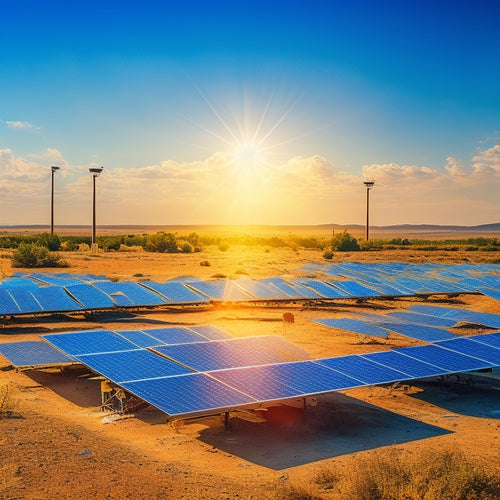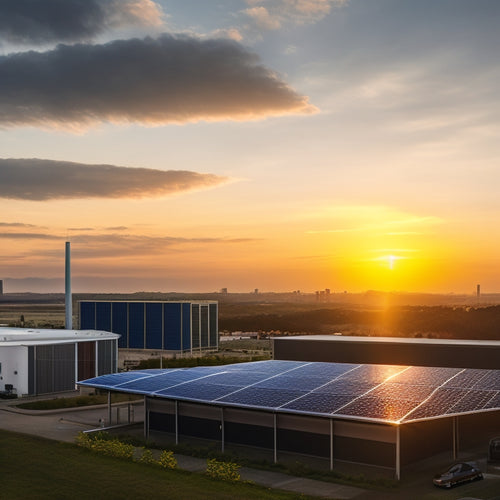
What Makes Solar Energy Systems Efficient
Share
To maximize the efficiency of solar energy systems, focus on advanced technology, ideal installation, and strategic location. High-efficiency panels, often exceeding 20% energy conversion rates, utilize innovative photovoltaic cells. Correctly tilting and positioning your panels guarantees ideal sunlight exposure, while a thorough shading analysis can prevent energy loss from obstructions. Additionally, influence your system's performance by considering temperature coefficients; lower coefficients enhance output in hotter conditions. With a clear understanding of these factors, you'll not only reduce energy costs but also contribute to sustainability. Keep exploring to reveal deeper understandings into enhancing your solar investment.
At a Glance
- High-efficiency panels, typically above 20%, convert more sunlight into electricity, increasing overall energy output.
- Advanced photovoltaic technology optimizes performance, enhancing energy conversion rates under various conditions.
- Lower temperature coefficients in panels lead to better efficiency, particularly in hotter climates, minimizing performance loss.
- Strategic solar orientation and shading analysis ensure maximum sunlight exposure, significantly improving energy generation.
- Battery storage solutions allow for excess energy utilization, ensuring a consistent supply even during outages.
Cost-Effective Energy Solution
When you consider solar energy systems, you'll find they greatly reduce long-term expenses compared to traditional energy sources.
With the potential to lower energy costs by 50-75%, many homeowners save between $400 and $1,000 annually.
Additionally, various government incentives can further enhance the financial viability of your investment, including financial incentives like tax credits and rebates.
Lower Long-Term Expenses
Although initial investments in solar energy systems can seem intimidating, the long-term financial benefits often outweigh these upfront costs. By utilizing solar power, you can greatly reduce your monthly energy expenses, moving toward true energy independence. As utility rates continue to rise, locking in your energy source through solar guarantees that you're protected from fluctuating costs.
Maintenance costs for solar panels are typically minimal, especially when compared to traditional energy systems. Most solar panels come with warranties that last 25 years or more, which means you can enjoy peace of mind knowing that your initial investment is safeguarded.
Regular maintenance usually involves simple cleaning and occasional inspections, which require far less financial commitment than maintaining fossil fuel-based systems.
Moreover, the savings from solar energy can accumulate rapidly, allowing you to reallocate funds to other areas of your life. Imagine the freedom of no longer being tethered to rising energy bills.
Government Incentives Available
Government incentives play an essential role in making solar energy systems a cost-effective solution for homeowners and businesses alike. By leveraging federal tax credits, you can greatly reduce your upfront costs when installing solar panels. These credits can cover a substantial percentage of your investment, making solar more accessible.
State rebates further enhance the affordability, allowing you to recover additional expenses. You may also want to take into account renewable energy certificates, which can provide an ongoing revenue stream as you generate clean energy.
Financing options, such as low-interest loans or leasing programs, make it easier to manage initial costs without sacrificing freedom. Installation grants are available in some regions, offering direct financial assistance to promote solar adoption.
Additionally, net metering benefits allow you to sell excess energy back to the grid, resulting in lower utility bills. Property tax exemptions guarantee that your solar investment won't increase your property taxes, providing further financial relief.
With various loan programs customized to different budgets, it's clear that the government's commitment to renewable energy creates a favorable environment for you to adopt solar technology efficiently. These incentives not only reduce your financial burden but also enable you to contribute to a sustainable future.
Environmental Impact Reduction
When you implement solar energy systems, you're drastically reducing carbon emissions, which directly contributes to a cleaner atmosphere.
By utilizing sustainable resources, you're not only meeting energy demands but also promoting environmental stewardship.
This shift leads to long-term savings on energy bills through renewable energy considerable savings on monthly electricity bills, resulting in a more resilient energy future that minimizes ecological footprints.
Reduced Carbon Emissions
Solar energy systems play an essential role in reducing carbon emissions, greatly lessening the environmental impact of energy production. By utilizing sunlight, you can greatly decrease your carbon footprint compared to fossil fuel-based energy sources.
Traditional energy generation methods release substantial amounts of CO2, contributing to climate change and air pollution. In contrast, solar energy systems produce clean electricity without emitting greenhouse gases during operation.
Implementing solar technology aligns with sustainable practices that prioritize environmental health and resource conservation. By choosing solar energy, you're not just investing in your energy independence; you're actively contributing to a cleaner planet.
The shift to solar reduces reliance on carbon-intensive energy sources, enabling you to influence positive environmental change. Moreover, the scalability of solar systems means you can tailor solutions to fit your needs while maximizing efficiency and minimizing emissions.
As solar technology continues to evolve, efficiency improves, making it easier for you to adopt renewable energy solutions. This innovation not only enhances your energy resilience but also amplifies the collective effort to combat climate change.
Sustainable Resource Utilization
As the shift to solar energy reduces carbon emissions, it also promotes sustainable resource utilization, which is key to minimizing environmental impacts. By adopting renewable sourcing, you're contributing to energy independence and enabling effective resource management. This change nurtures sustainable practices that enhance ecological benefits and drive community engagement.
To illustrate the impact of sustainable resource utilization, consider the following table:
| Aspect | Description | Benefits |
|---|---|---|
| Resource Optimization | Efficient use of materials and energy | Reduces waste and costs |
| Green Technologies | Innovations in solar systems and installations | Enhances performance and efficiency |
| Community Engagement | Involvement of local stakeholders in projects | Strengthens local economies and networks |
Panel Efficiency Ratings
When evaluating panel efficiency ratings, you'll need to take into account the conversion rate factors that determine how effectively solar panels change sunlight into electricity.
Additionally, the temperature coefficient plays an essential role, influencing performance as environmental conditions change.
To further improve your solar energy system's performance, selecting top solar battery picks can guarantee ideal energy storage and utilization.
Understanding these elements will help you enhance your solar energy system for maximum efficiency.
Conversion Rate Factors
In recent years, advancements in technology have considerably influenced conversion rate factors, particularly panel efficiency ratings. You've likely noticed that the solar panel technology available today outperforms older models, thanks to innovations in materials and design.
This shift has led to improved energy conversion efficiency, which measures how effectively a panel alters sunlight into usable electricity.
When selecting a solar panel, you should pay attention to its efficiency rating, typically expressed as a percentage. Higher ratings indicate that more of the sun's energy is converted into electricity, directly impacting your energy output and return on investment.
For instance, panels with efficiency ratings above 20% are now more common, offering a significant advantage in limited space situations.
Additionally, the integration of advanced photovoltaic cells, such as monocrystalline and bifacial designs, plays an essential role in optimizing performance.
By understanding these conversion rate factors, you can make informed decisions that align with your energy needs and minimize environmental impact.
Ultimately, embracing state-of-the-art solar panel technology enables you to utilize the sun's energy more effectively, leading to a sustainable and freedom-driven energy future.
Temperature Coefficient Impact
The temperature coefficient of a solar panel greatly influences its efficiency ratings, particularly in varying climatic conditions. Understanding temperature sensitivity allows you to optimize your solar energy systems for maximum output. As temperatures rise, most panels experience a drop in efficiency, which is quantified by their temperature coefficient. This value indicates how much the panel's performance decreases with each degree Celsius above a standard temperature, usually 25°C.
Here's a simple breakdown of how temperature impacts efficiency:
| Temperature Coefficient | Efficiency Loss (%) | Panel Type |
|---|---|---|
| -0.3%/°C | 10% at 35°C | Monocrystalline |
| -0.4%/°C | 12% at 35°C | Polycrystalline |
| -0.5%/°C | 15% at 35°C | Thin-film |
| -0.2%/°C | 8% at 35°C | Bifacial |
| -0.25%/°C | 10% at 35°C | PERC technology |
Selecting Based on Energy Output
When selecting solar panels, you need to take into account their efficiency ratings alongside your location and sunlight exposure.
High-efficiency panels can enhance energy output efficiency considerably, especially when optimized for maximizing energy output efficiency through adjustments in tilt and angle.
However, their performance heavily relies on how much direct sunlight they receive throughout the year.
Panel Efficiency Ratings
Choosing solar panels based on their efficiency ratings is essential for maximizing energy output and guaranteeing a worthwhile investment. Different panel types, such as monocrystalline, polycrystalline, and thin-film, exhibit varying efficiency levels. Recent technology advancements have notably improved the energy conversion rates of these panels, making them a significant consideration in your selection process.
When you evaluate efficiency, consider not just the panels themselves but also the installation techniques that can enhance performance. Proper alignment and orientation can notably impact energy yield. Additionally, effective maintenance practices are crucial; regular performance monitoring helps detect and rectify issues that could diminish output.
Moreover, integrating energy storage solutions guarantees you can utilize excess energy, providing freedom from grid dependency. Grid integration plays a significant role in optimizing energy usage as well.
Warranty considerations are also important; panels with longer warranties often indicate better quality and reliability.
Stay informed about market trends and consumer preferences, as these factors influence the availability and advancements in solar technology. By carefully analyzing efficiency ratings alongside these aspects, you can make informed choices that align with your energy goals.
Location and Sunlight Exposure
Maximizing solar energy output also hinges on location and sunlight exposure. To truly utilize the sun's power, you'll need to assess your site's solar orientation. This involves determining the direction your panels will face, as a south-facing orientation generally captures the most sunlight throughout the day.
Conducting a shading analysis is equally important. You'll want to identify any potential obstructions—like trees, buildings, or even chimneys—that could cast shadows on your solar panels. Even partial shading can greatly reduce energy production, so knowing the shading patterns at different times of the year will help you enhance panel placement.
Consider geographic factors as well. Areas closer to the equator receive more direct sunlight, while regions with frequent cloud cover or high pollution can hinder efficiency. By selecting a location with ideal sunlight exposure, you can boost your solar energy system's performance, granting you greater energy independence.
Ultimately, your choice of location, combined with strategic solar orientation and careful shading analysis, will enable you to maximize the benefits of solar energy, giving you the freedom to generate your own power sustainably.
Long-Term Savings on Bills
When you install a solar energy system, you're not just investing in clean energy; you're also setting the stage for significant reductions in your energy bills.
Over time, these savings accumulate, often offsetting the initial costs of installation.
Reduced Energy Costs
Investing in solar energy systems can lead to significant long-term savings on your energy bills, often reducing costs by 50% or more. By utilizing the sun's power, you gain a tangible pathway to energy independence. This shift not only diminishes your reliance on traditional grid power but also mitigates the unpredictability of energy prices.
As your system generates electricity, you'll notice a direct impact on your monthly expenses. The initial investment in solar technology pays off over time through decreased utility bills, which can translate into substantial savings.
Furthermore, with advancements in solar technology, the efficiency of panels has improved, enhancing their output and reliability.
Grid reliability becomes another key advantage. When your solar system is paired with battery storage, you can store excess energy for use during cloudy days or at night, ensuring a consistent energy supply. This capability further strengthens your energy independence, allowing you to manage power outages without disruption.
Ultimately, by adopting solar energy, you're not just saving money; you're embracing a sustainable future, reducing your carbon footprint, and securing your financial freedom from escalating energy costs.
Frequently Asked Questions
How Does Sunlight Intensity Affect Solar Panel Performance?
Sunlight intensity directly impacts your solar panels' performance. When sunlight angle is ideal and shading effects are minimal, you maximize energy capture, ensuring efficiency. Adjusting your setup for these conditions enhances your system's overall output.
What Maintenance Is Required for Solar Energy Systems?
To maintain your solar energy system, guarantee regular system cleaning and inverter upkeep. This keeps components functioning at their best, maximizing energy output and prolonging lifespan, allowing you to utilize the sun's power efficiently and independently.
Can Solar Panels Work During Cloudy Weather?
Yes, solar panels can still generate energy during cloudy weather, though cloud cover reduces energy output. They're designed to capture diffuse sunlight efficiently, ensuring you utilize as much power as possible, even when skies are gray.
How Do Solar Batteries Enhance System Efficiency?
Solar batteries enhance system efficiency by storing excess energy for later use, ensuring you maximize your solar investment. Their longevity impacts battery lifespan, providing reliable energy storage that elevates your independence and reduces reliance on the grid.
What Incentives Are Available for Solar Energy Installation?
When you consider solar energy installation, investigate federal tax credits, state rebates, local incentives, financing options, energy buyback programs, and installation grants. These can greatly reduce costs and enhance your energy independence while promoting sustainability.
Explore More
Just like a well-tuned orchestra, solar energy systems harmonize efficiency and sustainability, creating a concerto of savings and environmental benefits. By choosing the right panels and understanding their performance, you're not just investing in energy; you're composing a future where your bills shrink while Mother Earth breathes easier. Welcome this innovative solution, and watch your energy woes change into a melody of long-term advantages, all while contributing to a greener tomorrow.
Related Posts
-

What Happens Without a Charge Controller in Solar Panels
Without a charge controller in your solar panel system, you risk overheating batteries due to overcharging, which can...
-

Top 10 Off Grid Camping Gear Must-Haves
When you're off-grid camping, the right gear is crucial for a smooth expedition. Start with a durable, weather-resist...
-

Advantages of Commercial Solar Battery On-Site Storage
By investing in a commercial solar battery on-site storage system, you can greatly reduce your energy grid dependence...


